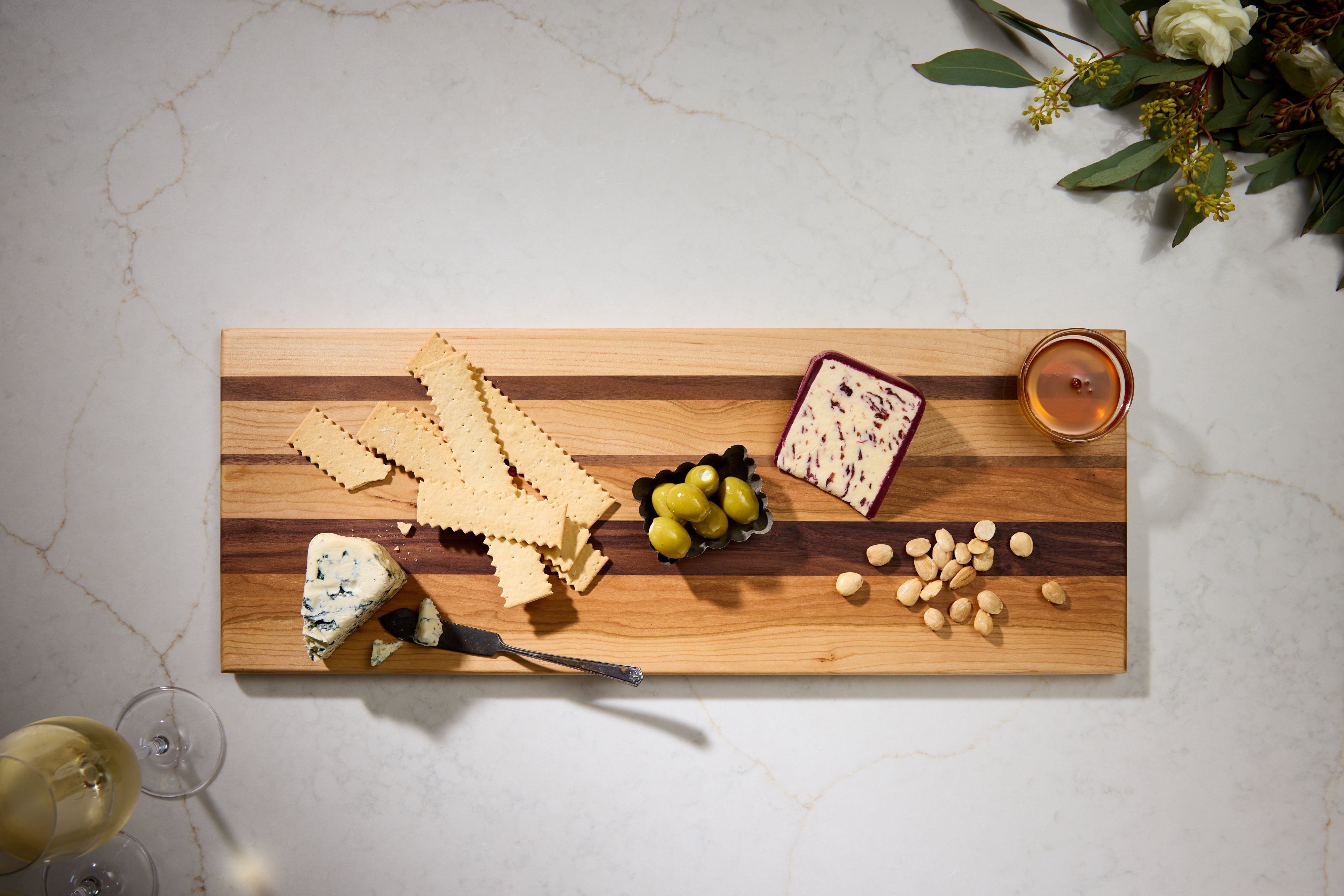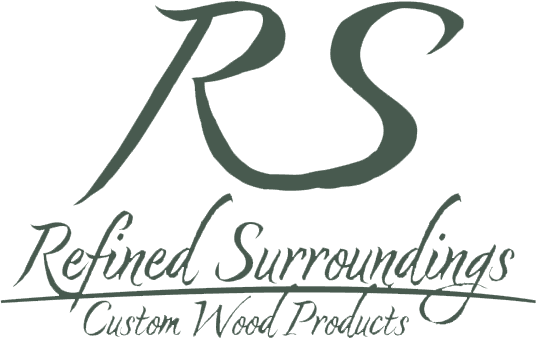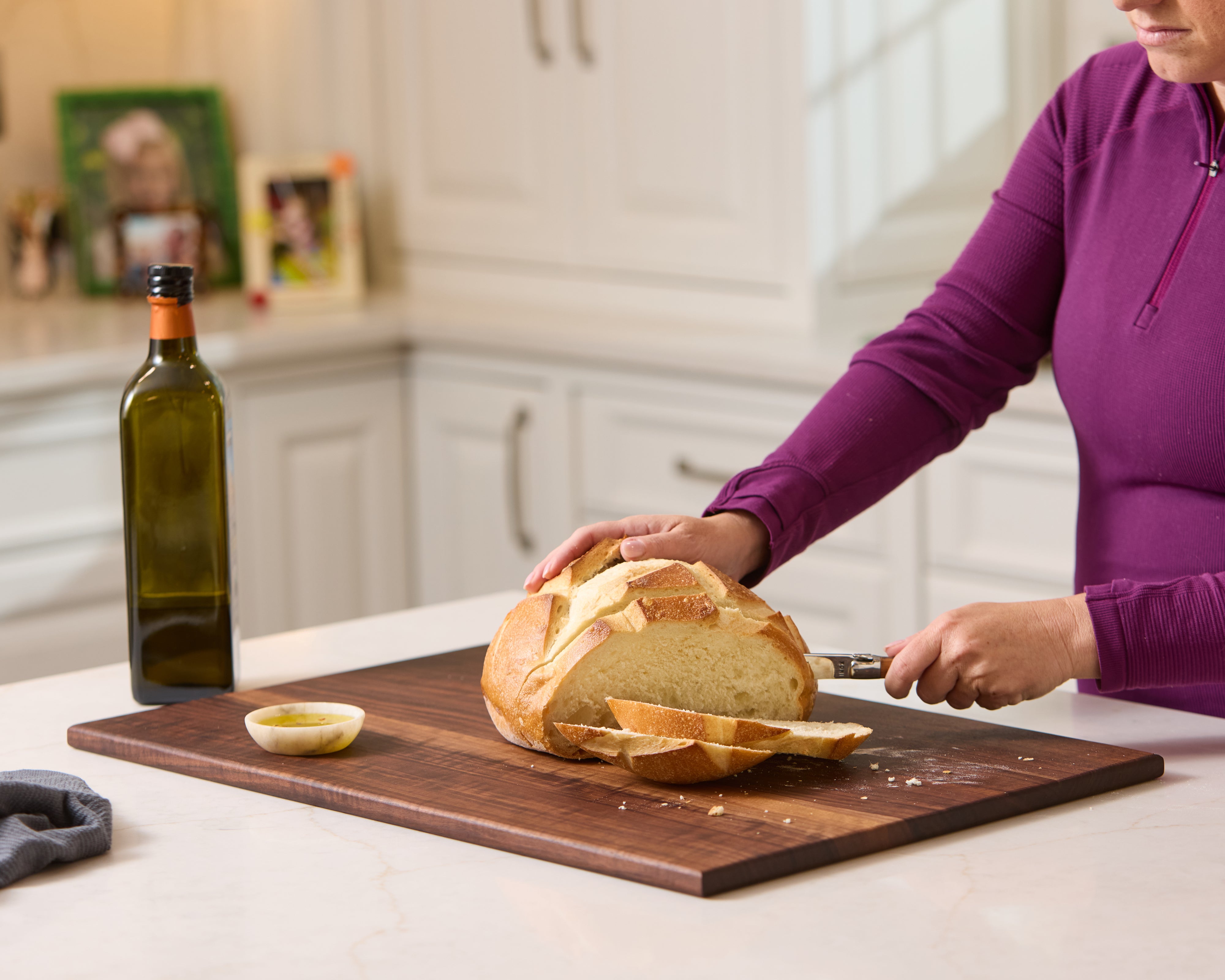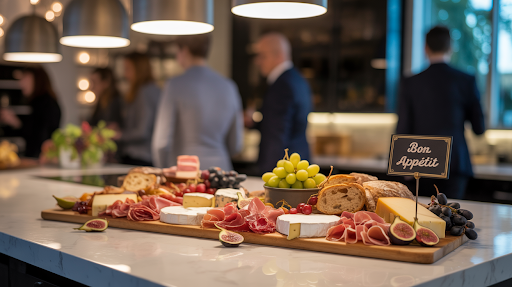
The Healthiest Cutting Boards: A Refined Essential for the Well-Curated Kitchen
Table of Contents
- Safest Cutting board Material: Wood Vs Plastic
- Why Your Cutting Board Matters
- Types of Cutting Boards: A Material Comparison
- What Makes a Cutting Board “Healthy”?
- How to Care for a Hardwood Cutting Board
- Top 5 Mistakes to Avoid with Your Cutting Board
- Why Walnut, Maple, and Cherry Are Top Choices
- Refined Surroundings Picks
- Frequently Asked Questions
- Conclusion: A Kitchen Essential, Elevated
In a space where wellness meets design, the cutting board is more than a tool, it’s a foundation. It’s where your meals begin and where your materials meet your values. Whether you’re prepping heirloom vegetables or slicing warm artisan bread, the surface beneath your knife matters more than many realize.
The healthiest cutting boards aren’t simply non-toxic; they’re thoughtfully made - safe, durable, sustainably sourced, and kind to both your kitchen tools and your body. For those who prioritize mindful living and elegant function, choosing the right board is a subtle but meaningful act of self-care.
In this guide, we’ll explore:
- The difference between common materials and what kind of cutting board is best
- How certain woods like walnut cutting board varieties support hygiene and longevity
- Why design, safety, and sustainability go hand-in-hand
- How to care for the board that cares for your kitchen
Every board has a story. The healthiest ones are built to last and to live beautifully alongside you.
Safest Cutting Board Material: Wood vs. Plastic
When choosing the healthiest cutting board, one of the biggest questions is whether wood or plastic is the safest cutting board material. Many people assume that plastic is safer, but in reality, studies show that plastic boards can trap bacteria in the knife grooves. Over time, these cuts also increase the risk of microplastics ending up in your food, which makes people wonder: are plastic cutting boards safe?
Wood cutting boards, on the other hand, are naturally antimicrobial. Hardwoods such as walnut cutting boards and maple cutting boards are durable, easy to maintain, and considered the best non toxic cutting boards for everyday use. They resist deep knife grooves better than plastic, and with proper care, they can last for years without compromising food safety.
That’s why experts and chefs agree that hardwood boards are the healthiest cutting boards to use in the kitchen, offering both safety and long-lasting quality.
Why Your Cutting Board Matters
A well-appointed kitchen isn’t defined solely by its aesthetics, it’s shaped by intention. From the cookware you reach for to the surfaces you prepare on, every choice reflects a balance of design, durability, and wellness. That’s especially true when it comes to something as quietly essential as your cutting board.
The healthiest cutting boards do more than resist wear. They protect your ingredients, preserve your tools, and support a way of living that values both safety and sustainability.
Here’s why your cutting board deserves more thought than most give it:
1. It's the First Contact Point for Your Food
The surface beneath your knife touches every fresh herb, every just-washed vegetable, every tender cut. If that surface harbors bacteria, sheds chemicals, or dulls your blades, it disrupts more than your workflow, it undermines your health and your tools.
2. Poor Materials Pose Real Risks
Many mass-market boards, particularly plastic and glass are convenient but problematic:
- Glass: Bacteria-resistant but brutal on your knives. It dulls blades quickly and increases prep time due to frequent sharpening.
- Low-grade composites: Often glued with adhesives that may not be food-safe, especially when exposed to moisture or heat.
- Plastic: Easy to clean, yes, but prone to deep grooves that harbor bacteria. Over time, it can also shed microplastics directly into your food.
If you're wondering what kind of cutting board is best, the answer begins with identifying the safest cutting board materials and understanding why hardwoods rise above the rest.
3. A Better Board Supports Longevity
Choose a well-made board, and you’ll find it becomes part of your routine in a quiet, meaningful way. Durable wood boards not only resist wear, they age gracefully, season well with care, and become heirlooms in their own right.
In Summary: The healthiest cutting boards do more than serve the moment, they support your kitchen’s rhythm for years to come. They protect your meals, your tools, and your values. And that’s worth investing in.
Types of Cutting Boards: A Material Comparison

Not all cutting boards are created equal and not all are created safe. To find the healthiest cutting boards, it’s essential to understand how different materials perform in real kitchens. From bacteria resistance to knife-friendliness, each material tells a different story.
Here’s a refined comparison to help you choose the safest cutting board material for your home:
Cutting Board Materials at a Glance
| Material | Pros | Cons |
|---|---|---|
| Plastic | - Inexpensive - Lightweight - Dishwasher-safe |
- Scars easily, trapping bacteria - Can shed microplastics - Often petroleum-based |
| Glass | - Doesn’t absorb liquids - Easy to sanitize |
- Dulls knives quickly - No surface give; harsh on tools |
| Bamboo | - Renewable - Lightweight - Appears eco-friendly |
- Too hard on knives - Can splinter or warp - Often bonded with adhesives |
| Composite | - Durable - Often dishwasher-safe |
- May contain resins or glues - Non-renewable, not knife-friendly |
| Hardwood (Walnut, Maple, Cherry) |
- Naturally antimicrobial - Gentle on knife edges - Durable & long-lasting - Visually timeless |
- Requires occasional oiling - Not dishwasher-safe |
Why Hardwoods Win in Wellness and Design
Among all available options, hardwood boards, especially walnut cutting boards, consistently rank among the best non toxic cutting boards you can own. Their combination of function, safety, and elegance makes them ideal for a kitchen designed around health and intention.
These boards are:
- Naturally resistant to bacteria (without the need for harsh chemicals)
- Durable enough for daily use, yet soft enough to preserve your knives
- Sustainably sourced from North American forests
- Designed to age beautifully over time with care, not compromise
What Makes a Cutting Board “Healthy”?
When curating a kitchen with intention, it’s not enough for a cutting board to be functional, it must be safe, sustainable, and enduring. The healthiest cutting boards aren’t just tools; they’re materials of trust, designed to support both your wellbeing and your culinary rhythm.
So, what kind of cutting board is best? The answer lies in four essential qualities:
1. Non-Toxic, Food-Safe Finishes
A healthy cutting board begins with what it doesn’t contain. Look for:
- Boards treated with food-grade mineral oil, not synthetic sealants
- Natural waxes or oils that protect wood without leaching into food
- Certifications or transparency about finishing products
2. Natural Antimicrobial Properties
Certain hardwoods, like walnut and maple, are naturally resistant to bacteria. Why it matters:
- Fewer chemicals are needed to sanitize your board
- Less risk of cross-contamination
- Supports cleaner prep with less effort
It’s part of what makes walnut cutting boards a staple among chefs who value hygiene and heritage alike.
3. Knife-Friendliness and Longevity
The safest cutting board material should protect your health and your knives.
Look for:
- Fine-grained woods that are gentle on blades
- Surfaces that resist scarring and cracking
- Solid, one-piece or laminated construction (no glues near food contact)
A high-quality board minimizes waste and maximizes performance.
4. Sustainably Sourced Materials
A healthy kitchen honors the planet as much as the palate. Boards made from:
- North American walnut, maple, or cherry
- Responsibly harvested wood (FSC-certified or similar)
- Brands that prioritize eco-conscious craftsmanship
The best non toxic cutting boards don’t compromise, they support your values from forest to countertop.
How to Care for a Hardwood Cutting Board
A finely crafted cutting board is not disposable, it’s a daily companion that deserves the same thoughtfulness you bring to your cooking. With mindful maintenance, even the most hardworking board will reward you with years of service and enduring beauty.
Here’s how to preserve the integrity of the healthiest cutting boards without fuss or compromise:
1. Clean Immediately After Use

- Wipe off any residue, then hand-wash with warm water and mild soap
- Use a soft sponge or cloth, never abrasive pads or steel wool
- Avoid citrus-heavy or bleach-based cleaners that can dry out wood
Never place your board in the dishwasher. Heat and moisture can warp or split even the strongest wood.
2. Dry Completely and Quickly

- Pat dry with a clean towel right after washing
- Let it air-dry vertically or on a rack with airflow
- Avoid stacking or laying it flat on damp surfaces, it traps moisture
3. Oil When the Surface Feels Dry

Regular oiling protects your board from cracks and keeps it water-resistant.
- Use food-grade mineral oil or a dedicated wood conditioner
- Apply with a soft cloth and let it absorb overnight
- Focus on the entire surface and edges for even hydration
Tip: If your board looks dull, feels rough, or absorbs water quickly, it’s time to oil.
4. Store With Intention

- Stand upright or store on a slatted rack
- Avoid dark, damp corners or flat cabinets where air can’t circulate
- If displaying, rotate periodically to ensure even wear
Proper care turns a simple board into a kitchen heirloom. Whether it’s a walnut cutting board used daily or a live-edge showpiece brought out for guests, maintenance is part of the ritual - quiet, minimal, and meaningful.
Top 5 Mistakes to Avoid with Your Cutting Board
Even the healthiest cutting boards benefit from a little intention. While these boards are crafted for durability, how you use and care for them can make all the difference, preserving both their beauty and their performance over time.
Avoid these common missteps to ensure your board stays at its best:
1. Placing It in the Dishwasher
A dishwasher may seem convenient, but for hardwood, it’s ruinous.
- Prolonged heat and water exposure can warp, crack, or split even the highest-quality board
- Always opt for a gentle hand wash and air-dry instead
2. Soaking It in the Sink
Letting your board sit in water saturates the wood fibers and invites damage.
- Excessive moisture can cause swelling, separation, or mold
- Instead, wash and dry promptly - never let it soak, even for a few minutes
3. Skipping Regular Oiling
Wood is naturally porous. Without oil, it dries out, leading to rough texture and surface cracks.
- A dry board is more prone to stains and water absorption
- Schedule oiling once a month, or when the board appears dull or thirsty
4. Ignoring Stains or Odors
Over time, food residue can leave its mark, literally and aromatically.
- Lingering smells and discoloration may signal bacterial buildup
- Clean deeply with a paste of lemon juice and salt, or a splash of white vinegar, then re-oil
5. Storing It Flat on Damp Surfaces
Flat storage traps moisture and creates uneven wear or mold underneath.
- Store upright or on a rack where air can flow freely
- Keep away from sinks, dish drying mats, or stovetops where steam may collect
Preserving your cutting board isn’t fussy, it’s foundational. With just a bit of care, your safest cutting board material will age gracefully and remain a kitchen mainstay for years to come.
Why Walnut, Maple, and Cherry Are Top Choices

The healthiest cutting boards don’t just perform, they elevate the kitchen experience. Materials matter, and for those who seek a balance of elegance, hygiene, and enduring craftsmanship, walnut, maple, and cherry stand apart.
These hardwoods aren’t chosen by accident. They’re selected for their integrity, to your tools, your food, and your values.
Walnut: Deep Beauty, Quiet Strength

Rich in tone and naturally resistant to bacteria, walnut cutting boards offer a surface that’s as functional as it is refined.
- Buttery texture that’s gentle on knife edges
- Antimicrobial by nature, requiring no harsh chemicals
- Deep chocolate grain that develops a handsome patina over time
This is the board that looks just as striking at a dinner party as it does during prep.
Maple: Classic, Clean, and Culinary-Tested

Preferred by professional chefs and home cooks alike, maple boards offer a clean, neutral palette with a resilient personality.
- Closed-grain surface helps resist moisture and bacteria
- Subtle grain makes it easy to spot residues and clean effectively
- Pairs beautifully with both modern and traditional kitchens
Maple embodies the balance between performance and polish, always dependable, never ordinary.
Cherry: Understated Elegance with Character

Warm and subtly red-toned, cherry boards are a favorite among those who appreciate detail and patina.
- Slightly softer than walnut and maple, exceptionally gentle on knives
- Ages with charm, gaining depth and character over the years
- Ideal for light prep, serving, or statement presentation pieces
Cherry speaks softly, but never fails to impress.
Together, these hardwoods represent the safest cutting board materials, naturally antimicrobial, non-toxic, and thoughtfully sourced. Their durability is a given. Their beauty, unmistakable.
Refined Surroundings Picks
At Refined Surroundings, each board is more than a tool, it's a piece of enduring design. Thoughtfully handcrafted from premium hardwoods, these selections reflect our commitment to quality, sustainability, and understated luxury.
Whether you're elevating your own kitchen or selecting a meaningful gift, these heirloom-caliber pieces are designed to serve with grace and intention.
1. The Signature Walnut, Maple & Cherry Board

A harmonious blend of three of the healthiest cutting board woods, this board is as versatile as it is visually striking.
- Ideal for daily prep or elegant serving
- Naturally antimicrobial, food-safe, and long-lasting
- A showcase of contrasting wood grains - functional design meets artisanal craft
Perfect for home chefs who value performance and presence in equal measure.
2. Extra-Large Cutting Board

Generous in scale, refined in detail, this board is made for those who love to cook (and love to host).
- Ample surface area for bread slicing, charcuterie spreads, or large-batch prep
- Durable hardwood build resists warping and staining
- Smooth beveled edges offer a subtle touch of design refinement
An ideal companion for entertainers, bakers, and weekend cooks alike.
3. Live Edge Walnut Charcuterie Board

Unmistakably artisanal, this piece bridges the line between prep and presentation.
- Crafted from premium walnut cutting board stock
- Retains the tree’s natural edge for a one-of-a-kind silhouette
- Sealed with food-safe oil for both protection and patina development
A board that starts in the kitchen and ends on your dining table, styled with intention.
Each piece in our collection is made to last, age beautifully, and tell a story, not only of what you’re making, but how you choose to live.
Frequently Asked Questions
Even the most seasoned home chefs have questions when it comes to choosing and caring for the healthiest cutting boards. Here are thoughtful answers to some of the most common ones:
Why replace plastic cutting boards?
Plastic boards may seem convenient, but they develop deep knife grooves that can harbor bacteria and shed microplastics into your food. They also lack the antimicrobial properties found in natural hardwoods.
How often should I oil my board?
A good rule: once a month or whenever the surface looks dry. Oiling helps your board resist water, stay smooth, and last longer. Use a food-safe mineral oil or board conditioner designed specifically for hardwood.
Hardwood vs. bamboo: which is better?
While bamboo is often marketed as eco-friendly, it's very hard and can dull knives quickly. Hardwood is a better choice, it’s more forgiving on your blades and far less prone to splitting over time.
Do I need separate boards for meat and vegetables?
It’s a wise practice, even with the safest cutting board materials. Either use separate boards or thoroughly clean with hot water and mild soap between uses to avoid cross-contamination.
What’s the best non toxic cutting board finish?
Look for boards treated with food-grade mineral oil or natural wax blends. Avoid boards with synthetic coatings, stains, or varnishes unless specifically labeled as food-safe.
Are plastic cutting boards safe to use?
While plastic cutting boards may seem convenient, they develop deep knife grooves that can trap bacteria and release microplastics into food. For this reason, they are not considered the safest cutting board material. Wood cutting boards, especially walnut and maple, are healthier and longer-lasting.
What is the healthiest cutting board material?
The healthiest cutting boards are made from hardwoods such as walnut and maple. These woods are naturally antimicrobial, non toxic, and more resistant to knife grooves than plastic. They’re widely recommended as the best non toxic cutting boards for safe food preparation.
Conclusion: A Kitchen Essential, Elevated
Choosing one of the healthiest cutting boards isn’t simply about avoiding the wrong materials, it’s about choosing to live with more intention. A handcrafted board made from walnut, maple, or cherry isn’t just safer and more sustainable, it’s a design choice that aligns with your values.
Whether you’re making everyday meals or sharing weekend spreads with friends, the right board enhances the ritual of cooking. It protects what matters: your ingredients, your tools, your home.
Explore the Collection
Refined Surroundings offers a curated line of cutting boards crafted for those who care deeply about form, function, and sustainability. Each piece is an invitation, to slow down, prepare with purpose, and bring beauty into the everyday.
Discover our artisan-crafted boards and find the one that speaks to your kitchen.



Leave a comment
This site is protected by hCaptcha and the hCaptcha Privacy Policy and Terms of Service apply.